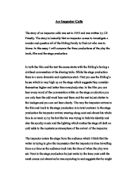Henry Irving instigated more changes than any previous theatre designer between 1878 and 1898. He was the first person to used coloured glass in front of lights, the first to use electric light, the first to paint the bulbs for effect and the first to think of dimming the house lights so the result of his ideas really showed up.
The electric theatre really arrived in 1882 when, at the Exposition in Munich Germany the first purpose built electric theatre was shown to the world.
With the introduction of electricity the changes, invention and advancement of lighting equipment and techniques has totally changed. Advancement through the first 30 years of the 20th Centuary were dramatic, with the power, out put and controllability of electric lights changing beyond all recognition.
The use of lenses to shape and control the beam of light, the introduction of Halogen Gas to achieve a brighter, more natural light, and specialized effects using light directed through special medium such as gels and water have revolutionized the lighting technician’s work. Where computer control and electronic dimmers that use variable resistors will take theatre lighting only the next few years will tell.
These pioneers have given a legacy to people working in stage lighting today. Their experimentation, failures and success can all be used to help today’s productions. It would be good to think there was innovation available to me but the equipment available is all tried and tested and therefore how it is used is limited.
However I have successfully used the established format of 2 Floodlights with 150 watt bulbs that gave me a sufficiently wide beam to each cover half a stage, and 4 Freznel Lanterns for directable beams, together with smaller spots with closer together lenses that gave a shorter focal length, and therefore a much more defined light. This was in a recent production of ‘The Terrible Fate of Terry Dumpton’ by David Calcutt. Allowing the stage to be well illuminated, but following and highlighting the principal characters.
I also used many special effects, the development of which has come directly from past innovators. In the police cell scenes of ‘Terry Dumpton’ I used a very pale thin blue jell mixed with very strong bright white light to create an effect of a cold stark police cell. For the pylon I used bright light to give the feeling of being out of doors. When the fatal accident occurs I combine blacking out all the lighting with a sudden burst of strobe lighting. The pre existing blue hues of the drama studio perfectly compliment the strobe light to give a subconscious blue effect, making the impression of an enormous electric spark very effective.
For the soliloquies that help to explain the story line I fade between bright light down to one spot light. This gives a very mean effect, and makes the area around the speaker seem as black as their words.
I feel that the lighting board the school has is limiting in that it is not computer linked. I am looking forward to exploring and expanding techniques in this direction should I have access to such equipment in the future.







